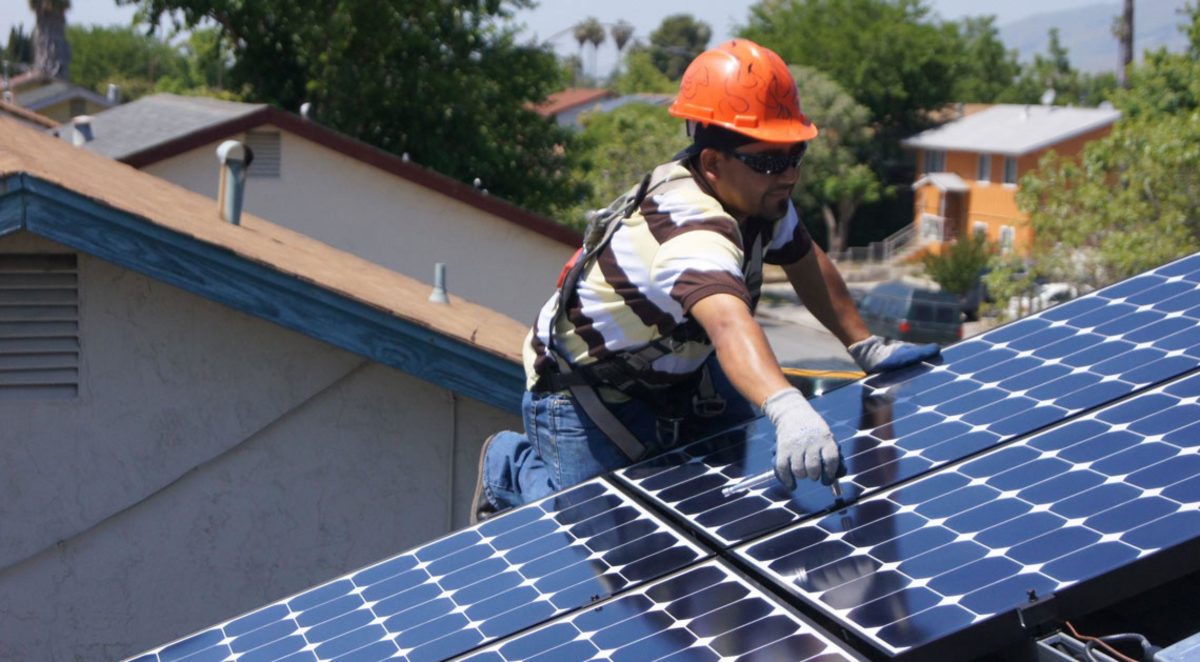Regulators from the California Air Resources Board (CARB) released a comprehensive report outlining the state’s path to carbon neutrality, and chief among the recommendations was support for solar, specifically rooftop solar. However, regulators from the California Public Utilities Commission (CPUC) have been developing policies that are set to slash the value of rooftop solar in the state.
California’s rooftop solar industry represents over 1.4 million homes, small businesses, and other structures topped with PV. The state accounts for 50% of rooftop solar installations in the United States, and of the 230,000 people employed in the solar industry, as many as 68,000 jobs are supported by the state’s rooftop solar business.
Based on California’s clean energy goals, as much as 28.5 GW of rooftop solar needs to be installed through 2045, according to Environment California. If all this capacity were instead installed on land, 148,000 acres would be needed to support it, an area about half the size of Los Angeles.
However, current policies under development in the state, namely the Net Energy Metering (NEM) 3.0 policy, are set to lower the value of solar in the state. The original proposal of NEM 3.0, supported by California’s three large investor-owned utilities was considered an outright disaster for those who supported the buildout of rooftop solar in the state. The proposal was delayed for a couple months after thousands of Californians took to the streets to protest the decision, which was labeled as a “tax on the sun.”
Now, NEM 3.0 is revisited, and it appears the policy still involves plans to reduce the value of rooftop solar, going in direct contrast to CARB’s clean air recommendations. The revised NEM tapers down the value for homeowners’ excess solar generation, using a “glide path” over four years to bring net metering values to the “avoided cost” for the utility, a fraction of what the utility charges for electricity.
It also introduced “non-bypassable charges,” which would add $0.05/kWh to a customer’s bill, whether or not they own solar. These charges would apply to the electrons generated by the customer’s rooftop solar array and delivered to their own homes. Regulations make it very difficult, or even illegal, to disconnect from the grid entirely in many areas in California.
This means that even if the customer completely self-consumes solar energy and doesn’t use utility-generated power, the utility will profit from the homeowner’s system via non-bypassable charges.

Image: EWG
“Gov. Newsom should listen to the state’s top clean air officials, not the utility-captured electricity regulators, and use his authority to protect the state’s rooftop solar program,” said Environmental Working Group president Ken Cook.
“It is imperative the governor reject the plot by utilities to undermine one of the main pillars of CARB’s roadmap to ensure renewable energy is the dominant source of electricity in the state. Anything less would send a clear signal that felonious, corrupt companies like PG&E can decelerate California’s progress in addressing the climate crisis,” he said.
CPUC is continuing to take comments on the new proposals in the revised NEM 3.0 until June 10.
This content is protected by copyright and may not be reused. If you want to cooperate with us and would like to reuse some of our content, please contact: editors@pv-magazine.com.









But what’s more important, reducing the ever-increasing disasters from climate change and getting us off of dirty fossil-fuels or maximizing utility investor profits? We’ll see what gets prioritized as time goes on.
I agree with the author that the energy I produce from my Tesla Solar Roof and consume should not be taxed or charged a fee by the utilities. The energy I send back to the utility and bank as a credit, rather than use my own batteries or when the batteries are full, could have a discount since the grid is being used as a battery. The argument here is how much as that electricity worth?
I have noticed on my bill that the cost of the energy I buy is 30% to 35% of the bills itemized costs. The rest of the bill is infrastructure for transmission lines, distribution, maintenance, repairs, legacy costs and profits for the utility up to 70% of the total charges. Since the energy I produce does not go back to the long-distance transmission lines but goes directly to the other homes in the neighborhood, I should not be charged for transmission of my energy. If you leave out transmission but take into account all the other charges and fees, using a 50% discount on the energy produced or a 2 for 1 exchange rate of energy produced to energy credited back would seem fair and equitable and the utility would make money on half of everything I sent back to the grid as it is charge for through my neighbors’ electrical meters in real time.
The only problem with this is the utility only allowed me to install 115% of my previous non-solar annual connected bills. NEM-3.0 was going to allow up to 200% of the previous annual bills on rooftops to give the homeowner a chance to install enough solar to pay the fees in their excess electrical generation rather than with cash. The problem with NEM-3.0 was they would also charge a monthly fee for the total rated output of the solar panels so installing up to 200% would cost more than the return on the extra solar installed. The monthly fee of $8.00 per kilo watt on a 16,000-watt system to reach the 200% mark would be a monthly fee of $128.00 each and every month or $1,536.00 per year or $38,400.00 over the 25-year lifetime of the system. This is the killer of rooftop solar in California that is totally unfair since only solar customers would be charged this fee.
We already pay a meter connection fee of $10.00 per month that every Houshold pays. If the homeowners with solar had a modest increase of an additional $10.00 if they did not have batteries connected also to the grid for emergency grid feedback and waived for those who opted into the emergency feedback program. that could be tolerated and get more homeowners to opt into batteries and back feed programs. Remembering that the homeowner is buying and building the rooftop system with their own money and the utility is not reimbursing the homeowners at all and California only lets homeowners install solar without raising the property taxes on their home for its value.
Before we cover farmland or put solar panels in deserts hundreds of miles from the consumers, we should cover every roof on homes, businesses and schools in California first before allowing utilities to cash in on our solar investments. They tried to put fees on rooftop solar in Nevada and killed the industry for 3 years and we cannot allow that to happen here in the Golden State.
“Before we cover farmland or put solar panels in deserts hundreds of miles from the consumers, we should cover every roof on homes, businesses and schools in California first before allowing utilities to cash in on our solar investments. They tried to put fees on rooftop solar in Nevada and killed the industry for 3 years and we cannot allow that to happen here in the Golden State.”
Absolutely agree!
255 Pages of more-n-more words…
Here is the Answer for a Zero Pollution California by.. 2050 or asap… (what the heck is Carbon Neutral.. ANYWAYS..)
Dump the rooftops.. as there are not enough roofs to meet the 2,200TWhrs/yr Energy needed by California in 2050 forva Zero Pollution California…
Here is the answer for California if it uses AgriVoltaics (AV)… JUST ONE PAGE…
AV System Size: 1.6 TW
Elec Generated: 2.29 TWhrs/yr
Energy Consumption: 48,800KWhrs/person/yr
AV Agricultural Land Needed: 9000 km2
AV Land Needed: 5%
AV System Cost: $2 Trillion (incl. Energy Stg).
Annual Revenue: $0.57Trillion/yr
Carbon Credits: $57 Billion/yr ($25/CC)..
One can easily generate a similar output using the CAV Calculator provided in http://www.zeropollution2050.com in a few minutes…
Ajay, this says it would pay for itself in 3.5 years. Do you believe that’s possible? If it is, why wouldn’t CA and other states jump on this solution immediately?
You linked to the site where the cpuc is taking comments but I’ve spent two hours reading and still can’t figure out how to comment. They seem to want to make public comments as difficult to submit as legally possible.
I searched and searched too and finally found that it’s Docket R2008020. And it’s at this webpage –
https://apps.cpuc.ca.gov/apex/f?p=401:56:0::NO:RP,57,RIR:P5_PROCEEDING_SELECT:R2008020
There, you click on “Add Public Comment”.
On that page, there’re about 15 people who made their comments visible to the public. You can choose to keep your comments, email addr, etc private if you wish.
Very True. I tried to find where to make a comment and never found the link to do so on the CPUC web site. Typing NEM-3.0 or any NEM configuration does not find any results. There are links to Numbered CPUC motions so if you can find that number, you might get somewhere. The California Public Utility Commission is run by big, centralized utility minded people from the industry and rooftop solar is “guerilla warfare” against big utility monopolies pushed through by liberal politicians that want to stop global climate change. In many countries, solar must be built to not connect to the grid just for this reason. Only if the utility can substantially profit from rooftop solar, like NEM-3.0 does, can the monopoly utilities survive because they need every customer in California to be paying into the system to keep it profitable and thus keep it in existence.
Again, it’s at this webpage –
https://apps.cpuc.ca.gov/apex/f?p=401:56:0::NO:RP,57,RIR:P5_PROCEEDING_SELECT:R2008020
There, you click on “Add Public Comment”.
Error Error processing condition.
ORA-01403: no data found
OK
This is the response I get to your link.
Sorry Edward, maybe it’s some setting in your browser? It worked again for me just now.